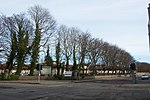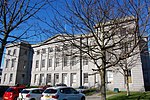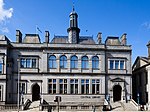Aberdeen ( (listen); Scots: Aiberdeen [ˌeːbərˈdin] (listen); Scottish Gaelic: Obar Dheathain [ˈopəɾ ˈʝɛ.ɪɲ]; Latin: Aberdonia) is a city in North East Scotland, and is the third most populous city in the country. Aberdeen is one of Scotland's 32 local government council areas (as Aberdeen City), and has a 2020 population estimate of
198,590 for the city of Aberdeen, and 227,560 for the local council area making it the United Kingdom's 39th most populous built-up area. The city is 93 mi (150 km) northeast of Edinburgh and 398 mi (641 km) north of London, and is the northernmost major city in the United Kingdom. Aberdeen has a long, sandy coastline and features an oceanic climate, with cool summers and mild, rainy winters.During the mid-18th to mid-20th centuries, Aberdeen's buildings incorporated locally quarried grey granite, which may sparkle like silver because of its high mica content. Since the discovery of North Sea oil in 1969, Aberdeen has been known as the offshore oil capital of Europe. Based upon the discovery of prehistoric villages around the mouths of the rivers Dee and Don, the area around Aberdeen has been thought to have been settled for at least 6,000 years.Aberdeen received royal burgh status from David I of Scotland (1124–1153), which transformed the city economically. The traditional industries of fishing, paper-making, shipbuilding, and textiles have been overtaken by the oil industry and Aberdeen's seaport. Aberdeen Heliport is one of the busiest commercial heliports in the world, and the seaport is the largest in the north-east part of Scotland. There are two universities in Aberdeen: the University of Aberdeen, founded in 1495 and located in Old Aberdeen, and Robert Gordon University which is located in Garthdee area and received university status in 1992.
In 2012, HSBC named Aberdeen as a leading business hub and one of eight 'super cities' spearheading the UK's economy, marking it as the only city in Scotland so designated. In 2018, Aberdeen was found to be the best city in the UK to start a business in a study released by card payment firm Paymentsense.









